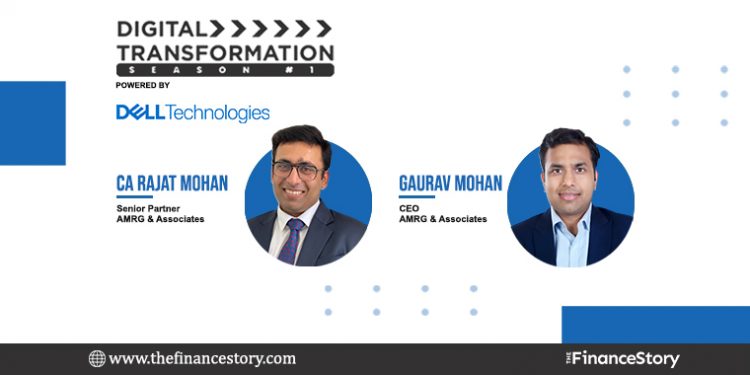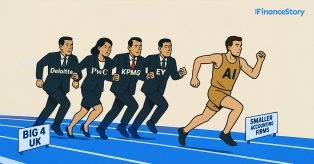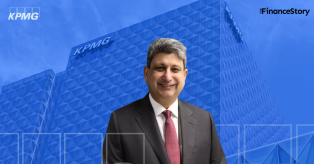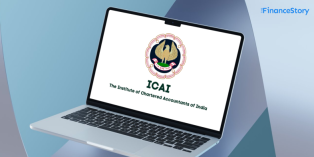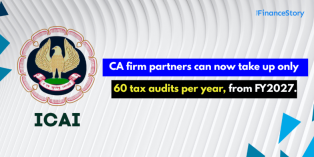- Meet senior partner CA Rajat Mohan and his CEO IITian brother Gaurav Mohan who took the family firm AMRG & Associates from a team of 10 in 2010 to 100 in 2021.
- With the growing firm’s needs and digitization being at the forefront, they have adopted technology in all three areas: Assurance, Litigation, and Compliance.
- As part of The Finance Story Digital Transformation series powered by Dell Technologies, we spoke to the Mohan brothers to understand their journey, what has been their tech strategy, and the challenges they face in finding the right software for their firm.
Tell us about yourself
Rajat Mohan (RM): I am a Chartered Accountant and Senior Partner at AMRG & Associates, a CA firm with a head office in Delhi.
Indian GST is my core practice area. I focus a lot on litigation and my next goal in the organization would be to grow the teams and take everyone along to the next level.
Gaurav Mohan (GM): I am an IITian with an MBA degree from IIM, Indore. I am the CEO of AMRG & Associates; almost everything in the organization is being managed under my supervision!
As a Senior Partner of a CA firm, what is digital transformation for you?
RM: “Digital Transformation” in my opinion is the evolution of the firm whereby the workforce evolves itself out of the traditional approach of doing business.
We need to improve the working style and environment of the entire firm, whereby the digital ecosystem is developed by increasing productivity and efficiency in the organization. In the years to come, this will reduce costs and improve profitability.
How have digital technology developments affected your firm in the last 5 years and especially last year?
GM: From the evolution of the dial-up web to portable internet dongles, we have all witnessed a part of this transformation. Post-pandemic, most business firms have switched their operations from manual to virtual platforms.
RM: Talking about our firm, in those days we used to rely on hard copies and physical interaction with the clients. However, due to the current situation, things have shifted to cloud data and Video calls.
Within the boundaries of our office, we can cater to clients across the country. In the recent past, we have depended on AI to bring quality to our services.
For Audit and Taxation, now we rely on software to do the analytical checking for maximum efficiency.
For instance just to help you understand how technology has helped us let me tell you about our Practice management software. As we grew we found the need to have practice management software. (In 2010, around ten people were working. Now in 2021, we accommodate a workforce of 100 people.)
Earlier people used to go on leave without informing. These were the problems embedded in our infrastructure and when you have an enormous workforce of hundred people, ten will always be facing problems. Those ten will hamper your productivity.
So, as we grew, I was not able to figure out how to check if all employees are working efficiently or not. That is when we adopted practice management software.
With this practice management software, every client and employee was mapped to a particular code. As a senior partner, at a press of a button, we could see who is working, at what time, their cost, and how much time they worked. During the day, they have to punch in everything.
Accordingly, every person will know which client they were dealing with, on which project they are supervising and its attributed expenses which get ultimately approved by a superior. A person is filling out the timesheet and his senior is responsible to approve or reject it.
At the end of the day, everything was mapped to a particular code. Individual efficiency down to every hour is worked out on a daily basis. This helped us even when 100% of our teams were working remotely.
To give you a perspective here is the timeline of our technology adoption:
2010-2015
- We started investing in hardware and bought 1 system per person in the organisation. We automated the HR processes including digital attendance.
2015-2017
- We started moving toward the deployment of paid application software for every compliance undertaken on behalf of the client. Lots of software for GST, E-Way Bills, & Income Tax were procured from the market.
- Around 2015-16, a lot of reports on GST started coming up and I was very passionate about GST so I wanted to specialize in this domain. At that point in time, people in the market who could understand GST were very few.
- Bigger clients sought out smaller firms that could provide them with good services. As a leader, I was proficient in high-level services and tax positions but they wanted to get a lot of compliance done too.
- Since 2016, it was very clear to me that it has to be through software if we want to move to the next level. Rather than being at the fag end of buying software, I was at the front end.
- In 2017, there was three software for GST. I bought all three of them. I did not know which one was right, which one would fit what so we bought all three of them.
- We realized that no software was apt for all the industries but all the software was apt for at least one industry. Using a mix of all the software, we were able to give quality services to all the clients.
2018
- We planned around investment in digital technologies in the assurance division. No new investment per se was made.
2019
- We invested in audit tools and allied technologies.
- With regard to audit tools, there were other technologies whereby one can get an online confirmation from a bank. Today, at the press of a button I can send it to 100 people, and then I can send reminders every seven days.
- This was the first technology concerning audit tools and for elite technologies, online confirmation was the best of those.
2020
- We invested in the cloud and online communication tools like MS Teams, and Zoom.
- We further invested in practice management software to cater to the increase in team strength and ensure efficiency.
- We have collaborated and partnered with a company to get specific software onboard for compliance filing. We’re here talking about both Direct and Indirect tax.
- The efficiency of the software can be justified by the fact that the indirect tax software is 100% on the cloud. Even though the direct tax is filed offline, we’ve created a mechanism that allows us to access it from anywhere in the World.
- Moreover, we’ve shifted our newsletters and GST updates to digital mode with tools placed for better market reach. Our decision to invest in digital products has been a huge success and has helped us store data on our company drives.
2021
- We have hired people specifically with digital skillsets including Graphic designers, and SMO experts. Website developers would be next on the charts.
- In terms of allotment of jobs to our employees, we got IFirm (Optimize Resource Allocation) management software onboard. The firm has not only helped us in managing our employees but also simplified their work here at AMRG. It also maintains a timesheet for accountability of business for our firm.
- Currently, we’re working on our customized CRM software for AMRG. Hopefully, it will be ready by the winter of 2022.
Considering the changing scenario of the Audit landscape during the pandemic, it becomes even more important to analyze and assess data and controls in different manners. What are you doing in this area?
RM: We have already procured a comprehensive Audit tool for the assurance team. It is being implemented for all large corporate clients, and by next year, every client will be audited through this software.
Post successful implementation of this software, we will work toward procuring an audit sampling software too.
Is an assessment done of all the tech products used at the moment and the ones which are very critical? Are the critical ones moved to the cloud?
GM: We in AMRG assess all our technology before implementing, right from doing our research to running through demos and pilot runs, speaking to the concerned executives with qualified expertise before procuring the technology, and also keeping it up to date after installation of the same.
By breaking down the process of assessment into a series of actionable, repeatable, and documented steps, we can be more informed and confident with our selection of technology.
Ultimately, we got all agree that it’s the need of the hour and we need to be very precise when it comes to selecting the right tool for the right task.
Technology assessment done prior to the technology adoption will reduce the risk of ineffective investment decisions and provide a robust structure to the organization by & large.
Most of our data from Direct & Indirect Tax filing is stored in the cloud for security reasons. 100% of the Indirect tax data is on the cloud.
Some of the Direct tax data is maintained on the Cloud and the rest in local drives, but the access is restricted to only a few.
Apart from that, our Audit & Audit samplings are done via software procured specifically for this purpose. Access is provided to Senior Partners & Managers and occasionally to other employees as per the requirement.
What is your IT implementation strategy?
The critical part is not only choosing the right technology but also implementing it in the organization.
Training the team to optimally use the technology is highly important without which however good software may be adopted will not garner benefits.
Thus we have made, IT Implementation as an inclusive task that essentially aims to approve all the stakeholders.
Our model of implementing technology is very simple – We form a team from the current list of professionals. Next, they are given a project to implement a particular technology.
This team will have at least 2 people who are very new in the organisation and one person who is with the organization for at least 5 years. This team directly reports to a partner every week and is practically freed from all other assignments for this project implementation.
From start to end these people are responsible for everything. After some time, generally one year, we entrust the project to another team for feedback and improvisations
As an Accounting firm, what are the challenges when it comes to finding the right tech? Whom do you consult for technology-related decisions?
RM: Gaurav being an IITian, is responsible for the Tech-related decisions in the organisation. He has his own list of friends from IIT to consult with. Besides I have friends in other bigger organizations and always keep a close tab on what they are investing in.
GM: The CA profession is still in the process of adopting technology, and many still believe in the old style of working. Because of this, there is limited software available in the market. Many of them are still in the nascent stages where bugs are yet to be fixed.
The government portal of taxation GSTN and Income Tax are undergoing a host of changes now and then. This indicates that the entire country’s financial systems are still adapting to the tech. This fluid environment makes it all the more important to choose more adaptable software.
For finding the right tech we look at what market leaders have adopted and then assimilate our cost analysis, demos and pilot runs before nailing it down.
Cost is an important factor in deciding on any tech product. Do you have a strategy to assess the cost benefits?
RM: Implementation cost will always be a major factor for any decision in business, but we firmly believe adopting the right tech at the right time is crucial.
Here the correct choice will compensate itself in due time. While the wrong choices even at cheaper costs will only affect the efficiencies.
To give you an example: We started practice management software in 2019. We analyzed what the cost per head would be. The one-time cost is generally very heavy in this kind of software including the training cost associated with it.
We mapped it into excel and saw what will be the benefit in the long term. We analyzed that it would be much more beneficial to invest in analyzing the cost that we were incurring for a job.
If it makes the task easier and saves time, we invest in the product.
How do you manage all the tech software and its maintenance? Do you have an in-house team to do all of that?
GM: We have a lot of software and it is right now difficult to hire a full-time IT person and then cater to their needs. We have tried to outsource many of these activities where we are not specialized.
Everyone is talking about Cloud Support: what does cloud mean to your firm?
GM: When we started working on GST in 2017, we were clear that this hardware model or these servers will not be long-lasting.
Since 2017, we have been moving all the indirect tax data to the software and cloud. We have slowly shifted most of the data to the cloud.
Access to the cloud system is attainable at any time and from any geographical location which helps in running the business with success while not missing a beat.
Since we’re flooded with almost tons of data every month, cloud drives become a basic need for our firm.
All senior partners & Managers at our firm have access to a shared drive where all documents pertaining to the firm are stored.




